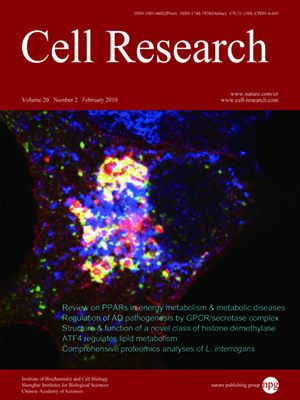
Volume 20, No 2, Feb 2010
ISSN: 1001-0602
EISSN: 1748-7838 2018
impact factor 17.848*
(Clarivate Analytics, 2019)
Volume 20 Issue 2, February 2010: 166-173
ORIGINAL ARTICLES
Structural insights into a novel histone demethylase PHF8
Lin Yu1,*, Yang Wang1,*, Shuo Huang2,*, Jianjun Wang1, Zengqin Deng1, Qi Zhang1, Wei Wu1, Xingliang Zhang1, Zhao Liu1, Weimin Gong3 and Zhongzhou Chen1
1State Key Laboratory of Agrobiotechnology, College of Biological Sciences, China Agricultural University, Beijing 100193, China
2Department of Biochemistry and Molecular Biology, National Key Laboratory of Medical Molecular Biology, Institute of Basic Medical Sciences, Chinese Academy of Medical Sciences and Peking Union Medical College, Beijing 100005, China
3State Key Laboratory of Biomacromolecules, Institute of Biophysics, Chinese Academy of Sciences, 15 Datun Road, Beijing 100101, China
Correspondence: Zhongzhou Chen,(chenzhongzhou@cau.edu.cn)
Dynamic regulation of histone methylation/demethylation plays an important role during development. Mutations and truncations in human plant homeodomain (PHD) finger protein 8 (PHF8) are associated with X-linked mental retardation and facial anomalies, such as a long face, broad nasal tip, cleft lip/cleft palate and large hands, yet its molecular function and structural basis remain unclear. Here, we report the crystal structures of the catalytic core of PHF8 with or without α-ketoglutarate (α-KG) at high resolution. Biochemical and structural studies reveal that PHF8 is a novel histone demethylase specific for di- and mono-methylated histone H3 lysine 9 (H3K9me2/1), but not for H3K9me3. Our analyses also reveal how human PHF8 discriminates between methylation states and achieves sequence specificity for methylated H3K9. The
in vitro demethylation assay also showed that the F279S mutant observed in clinical patients possesses no demethylation activity, suggesting that loss of enzymatic activity is crucial for pathogenesis of PHF8 patients. Taken together, these results will shed light on the molecular mechanism underlying PHF8-associated developmental and neurological diseases.
Cell Research (2010) 20:166-173. doi: 10.1038/cr.2010.8; published online 26 January 2010
FULL TEXT | PDF
Browse 2305


